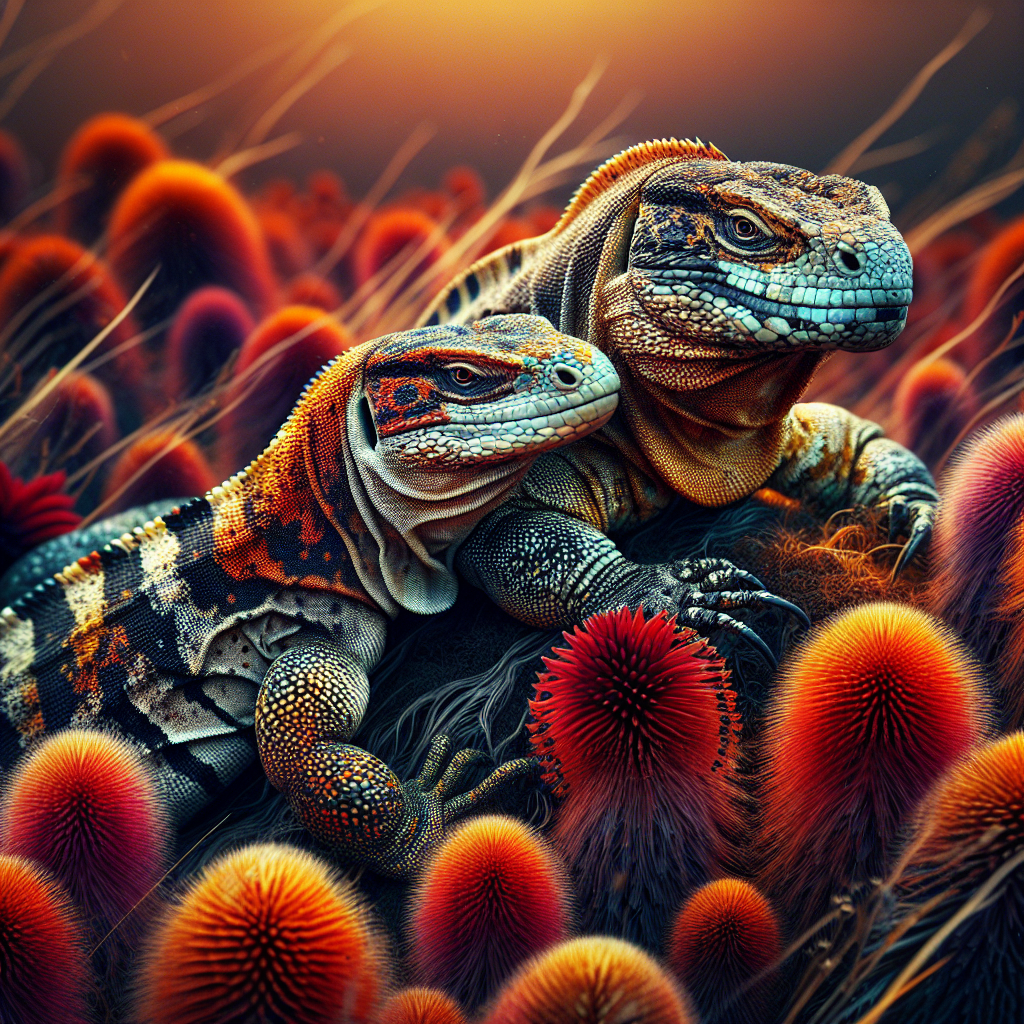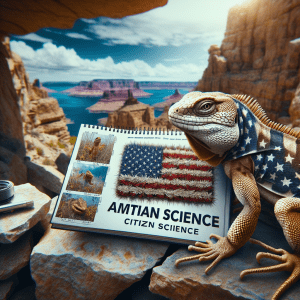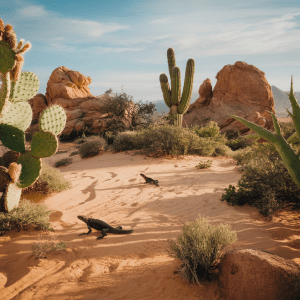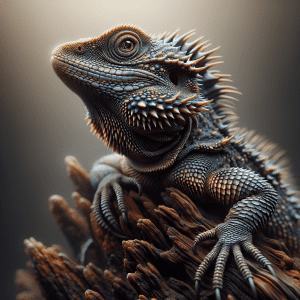Introduction: Understanding Lizard Predators and Prey in North America
Have you ever wondered about the intricate dance of predator and prey in the world of North American lizards? Picture this: a majestic lizard basking in the warm sun, unaware of the lurking predators nearby. It’s a tale as old as time, a battle for survival that shapes the delicate balance of nature.
As an expert in the field, I’ve witnessed firsthand the fascinating interactions between lizards and their predators. From agile birds of prey swooping down for a quick meal to cunning snakes stealthily stalking their unsuspecting prey, the strategies employed by these creatures never cease to amaze me.
Did you know that some lizards have developed remarkable camouflage techniques to evade detection by predators? It’s like a real-life game of hide-and-seek, with survival hanging in the balance. These small reptiles have mastered the art of blending in with their surroundings, giving them a fighting chance against their formidable foes.
Understanding the dynamics of predator and prey relationships in the lizard kingdom is not just a matter of academic interest—it has real-world implications for conservation efforts and ecosystem health. By delving into the intricacies of these interactions, we can gain valuable insights into how to protect these fascinating creatures for future generations to enjoy.
So, join me on this journey into the captivating world of lizard predators and prey in North America. Let’s unravel the mysteries of nature together and discover the hidden wonders that lie just beneath the surface.
Importance of Knowing Lizard Predators and Prey
Have you ever wondered about the intricate dance between predators and prey in the world of lizards? It’s a captivating saga that plays out every day in the wild. Picture this: a cunning snake slithering through the underbrush, stalking its unsuspecting lizard prey. The tension is palpable, the stakes are high. As a lizard expert, I’ve witnessed these predator-prey interactions firsthand, and let me tell you, it’s a sight to behold.
Did you know that certain lizards have evolved remarkable defense mechanisms to outsmart their predators? Take the horned lizard, for example. When threatened, it can shoot blood from its eyes to deter predators – talk about a unique defense strategy! Nature is full of surprises, and the world of lizard predators and prey is no exception.
Navigating the predator-prey dynamic is a delicate balancing act for lizards. They must constantly be on high alert to evade danger and ensure their survival. But fear not, there are ways to help protect these fascinating creatures. By understanding the predators they face and the prey they rely on, we can work towards creating a safer environment for lizards to thrive.
So, the next time you spot a lizard darting across your path, take a moment to appreciate the complex web of life that surrounds these remarkable creatures. The world of lizard predators and prey is a mesmerizing realm waiting to be explored. Are you ready to dive into this captivating world with me?
Common Predators of Lizards in North America
When it comes to the common predators of lizards in North America, you might be surprised by the variety of creatures that view these scaly reptiles as a tasty snack. From snakes stealthily slithering through the undergrowth to birds of prey soaring high above, lizards face a constant threat from their natural enemies.
One interesting fact to consider is how some predators have evolved specialized hunting techniques to catch lizards. Take the roadrunner, for example. This iconic bird is known for its lightning-fast speed and keen hunting skills, making it a formidable predator for lizards in arid regions. Imagine the thrill of witnessing a roadrunner in action as it darts across the desert landscape in pursuit of its scaly prey.
As we delve deeper into the world of lizard predators, it’s essential to understand the crucial role they play in maintaining the balance of ecosystems. While predation can be a harsh reality for lizards, it also serves as a natural mechanism for controlling populations and ensuring the health of diverse habitats. So, the next time you spot a predator on the prowl, consider the intricate dance of life and death unfolding in the wild.
By learning about the common predators of lizards in North America, we gain a deeper appreciation for the intricate web of life that surrounds us. Nature’s drama plays out daily, with each predator and prey contributing to the rich tapestry of biodiversity. So, the next time you encounter a lizard in the wild, take a moment to ponder the challenges it faces and the predators that lurk in the shadows, shaping its survival journey.
Prey of Lizards in the North American Ecosystem
Alright, folks, let’s dive into the fascinating world of the prey that lizards snack on in North America. Have you ever stopped to think about the variety of creatures that lizards consider a tasty meal? It’s a wild world out there, and lizards play a crucial role in maintaining the balance of their ecosystems.
Picture this: a lizard stealthily stalking its prey, ready to pounce at any moment. The prey of lizards in North America ranges from insects like crickets and grasshoppers to small mammals such as rodents. It’s a survival game where each player has a part to play.
Now, here’s an interesting fact for you: Did you know that some lizards have developed specialized hunting techniques to capture their prey? For example, chameleons use their lightning-fast tongues to snatch insects with incredible precision. It’s like a real-life ninja move in the animal kingdom!
When we consider the prey of lizards, we also uncover a web of interconnected relationships in nature. Every creature, from the tiniest insect to the largest mammal, has a role to play in the grand scheme of things. So, how does the food chain work in the lizard’s world? It’s a complex dance of predators and prey, each relying on the other for survival.
As we explore the prey of lizards in North America, let’s appreciate the intricate balance of nature and the beauty of diversity in the animal kingdom. Next time you spot a lizard basking in the sun, remember the hidden world of creatures it relies on for its next meal. Nature truly is a marvel to behold!
Impact of Predation on Lizard Populations
Have you ever wondered how lizards manage to evade their predators in the vast wilderness of North America? It’s a fascinating dance of survival out there, folks. Picture this: a cunning coyote stalking its prey, the nimble lizard, across the rocky terrain. It’s like a real-life game of cat and mouse, only with a reptilian twist. These predators are no joke, my friends. They’ve honed their hunting skills over generations, making them formidable foes for our scaly friends. But fear not, the lizards have their own bag of tricks up their sleeves. With lightning-fast reflexes and camouflaging abilities that would make a chameleon jealous, they manage to stay one step ahead of their would-be captors. It’s a constant battle of wits and survival in the wild, where every move could mean the difference between life and death. So next time you spot a lizard darting across your path, take a moment to appreciate the intricate dance of predator and prey playing out right before your eyes. It’s nature at its most raw and captivating, a true testament to the resilience and adaptability of these remarkable creatures.
Strategies for Protecting Lizards from Predators
Imagine you’re out in the wild, observing lizards in their natural habitat. You may wonder how these small creatures manage to survive with so many predators lurking around. Well, my friend, let me tell you about the fascinating strategies lizards have evolved to avoid becoming someone else’s lunch.
One interesting fact about lizards is their incredible ability to camouflage themselves. Have you ever noticed how some lizards blend seamlessly into their surroundings, making them almost invisible to predators? It’s like they have their own invisibility cloak, but in a reptilian version!
Now, picture this: a hungry snake slithering towards a lizard basking in the sun. The lizard’s survival instincts kick in, and in a split second, it dashes for cover under a rock, leaving the snake baffled and empty-handed. It’s like watching a high-speed chase in the animal kingdom!
But here’s the kicker – not all lizards rely solely on speed and stealth. Some species have developed toxic skin secretions or sharp spines to ward off potential threats. It’s like having your own built-in defense system, always ready to deter any unwanted advances.
So, the next time you spot a lizard darting across your path, take a moment to appreciate the complex dance of predator and prey that unfolds in the natural world. It’s a constant battle for survival, where every species has its own unique tricks up its sleeve. And who knows, maybe you’ll discover a newfound admiration for these resilient reptiles that call North America their home.
How Lizards Adapt to Avoid Predation
Have you ever wondered how lizards manage to evade their predators in the wild? It’s a fascinating survival dance that these reptiles have perfected over millions of years. Picture this: a lizard darting across the desert sands, its sleek body blending seamlessly with the environment to avoid detection by hungry predators. It’s like a high-stakes game of hide-and-seek, with the lizard’s life on the line.
One interesting fact about how lizards adapt to avoid predation is their incredible speed and agility. These creatures have evolved to be swift runners and adept climbers, allowing them to escape danger with lightning-fast reflexes. Imagine being able to outrun your potential captor in the blink of an eye – that’s the reality for lizards in the wild.
But it’s not just about speed – lizards also employ clever camouflage techniques to stay hidden from their predators. Some species can change their skin color to match their surroundings, making them virtually invisible to the naked eye. It’s like having a built-in invisibility cloak, helping them stay one step ahead of their would-be attackers.
So next time you catch a glimpse of a lizard effortlessly scurrying across your path, take a moment to appreciate the intricate survival strategies at play. These seemingly simple creatures have mastered the art of evading predators through a combination of speed, agility, and cunning camouflage. It’s a mesmerizing display of nature’s ingenuity – a true testament to the wonders of the animal kingdom.
Role of Lizards in the Food Chain
Ever wondered how lizards fit into the grand scheme of things in the wild? Well, let’s dive into the fascinating world of lizards and their crucial role in the food chain. Picture this: a lush forest buzzing with life. Birds chirping, insects buzzing, and lizards stealthily making their way through the undergrowth. But have you ever stopped to think about what lizards actually eat and how they contribute to the ecosystem?
Lizards, my friends, are not just cute reptiles basking in the sun; they are essential players in maintaining the delicate balance of nature. These scaly creatures play a vital role in controlling insect populations, acting as natural pest control agents. Imagine a world overrun by creepy crawlies if it weren’t for our lizard friends feasting on them.
But here’s the kicker – lizards themselves are on the menu for many other predators. From snakes and birds to larger mammals, everyone wants a piece of the lizard pie. It’s a tough world out there for these little reptiles, constantly on the lookout for danger lurking in every shadow.
So, how do lizards manage to survive in this high-stakes game of predator and prey? Stay tuned as we uncover the clever strategies lizards employ to outsmart their foes and stay one step ahead in the survival race. It’s a wild ride, filled with intrigue, danger, and a whole lot of lizard cunning. Get ready to be amazed by the incredible world of lizard predators and prey!
Conservation Efforts to Protect Lizard Species
Conservation efforts to protect lizard species are crucial in maintaining the balance of ecosystems. Imagine a world without these scaly marvels slinking around; it’d be a dull place, don’t you think? Let me tell you, these creatures play an essential role in keeping the food chain in check. It’s like a well-choreographed dance – each step vital to the performance.
Now, picture this – a world where lizards disappear due to unchecked predation. The ripple effects would be catastrophic. It’s not just about these reptiles; it’s about the intricate web of life they’re part of. Every species has a role to play, and lizards are no exception.
Have you ever thought about what you can do to help protect these creatures? It’s not just up to scientists and conservationists; every individual can make a difference. Simple actions like creating lizard-friendly habitats in your backyard or supporting conservation efforts can go a long way in ensuring these fascinating creatures thrive for generations to come.
So, the next time you spot a lizard basking in the sun or darting across your path, take a moment to appreciate the beauty of these creatures and the vital role they play in the natural world. Let’s work together to protect and preserve these amazing animals – our planet wouldn’t be the same without them.
Conclusion: Promoting Harmony in the Lizard Ecosystem
Have you ever stopped to ponder the intricate dance of predator and prey in the vast wilderness of North America? It’s truly a mesmerizing spectacle, filled with drama and suspense at every turn. Picture this: a stealthy rattlesnake patiently waiting to strike at an unsuspecting lizard basking in the sun. It’s a scene straight out of nature’s most riveting script.
The fascinating thing about lizard predators and prey is the delicate balance that exists between them. It’s a classic game of survival, where each player must outwit the other to thrive in their ecosystem. Did you know that some lizard species have developed unique camouflage techniques to evade their predators? Nature’s creativity knows no bounds!
One practical tip for lizard enthusiasts is to create a predator-proof enclosure for your pet lizards. By providing a safe haven, you can ensure their well-being and security against potential threats. It’s like giving them their own little fortress in the wild world of North America.
As we delve deeper into the world of lizard predators and prey, it becomes clear that these interactions have far-reaching implications for the ecosystem. Every predator serves a crucial role in maintaining the delicate balance of nature, ensuring that no single species dominates the landscape. It’s a symphony of life, where each note plays a vital part in the grand composition of the wild.
So, the next time you spot a lizard darting across your path, take a moment to appreciate the intricate web of predator and prey that surrounds us. It’s a testament to the beauty and complexity of the natural world, reminding us of the wonders that unfold right in our own backyard.




